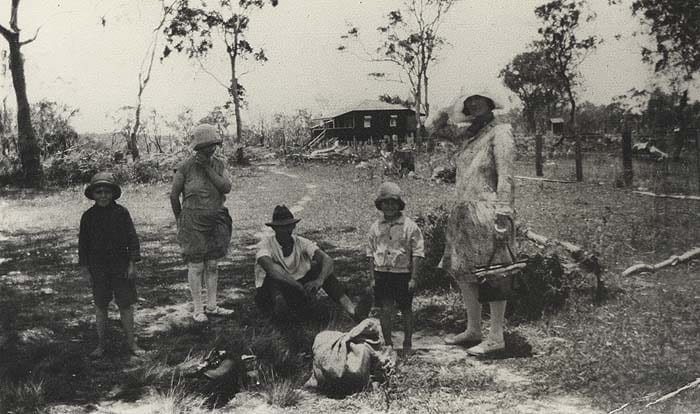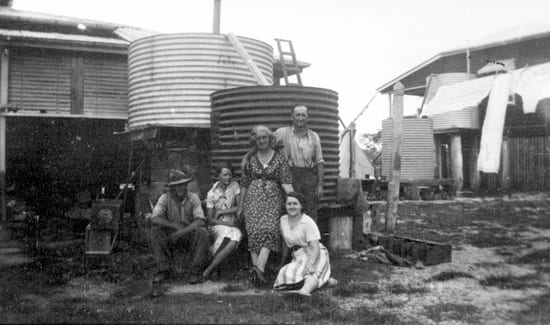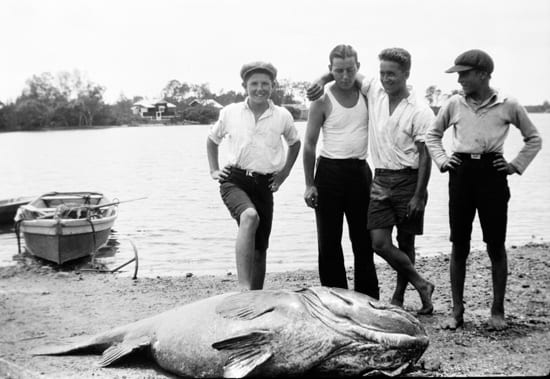One of the first houses built on Gympie Terrace was Miner’s Rest, built by Richard (Dick) Parkyn around 1896.

A young Howard Parkyn holding sharks jaws in front of his grandparents’ Miner’s Rest, 1917
Richard Bray Parkyn, a Cornish tin miner, migrated to Gympie in the 1880s to become a manager at the gold mines. On his journey, he passed through Tewantin and purchased land on Gympie Terrace, what is now number 219. In Gympie, he met and married Margaret (Maggie) Shields. They had seven children.

Jack & Daisy Parkyn with their family in front of the first house at Munna Point, circa 1925
In 1925, Dick and Maggie’s second son, John, known as Jack, and his Cornish wife, Daisy, returned to Gympie Terrace and bought the boat Miss Tewantin. Jack had accompanied his parents to England in 1905 as an eighteen-year-old when he met the young Daisy. The young couple had maintained contact via letters for seven years before Daisy finally moved to Australia in 1912. They worked on a farm at Wolvi before Jack got a job at the butter factory in Gympie

Jack, Howard & Daisy Parkyn aboard Miss Tewantin, late 1920s

A fishing crew aboard Miss Tewantin, 1930s
Miss Tewantin was a 60-passenger launch, primarily used for transporting people from Tewantin to Noosa Heads and back. But it was also used for tourist trips to the lakes and to the coloured sands via the river and Teewah landing. Sometimes it would also freight fish to Brisbane and bring back supplies, including materials that Jack used to build houses and a shop at Munna Point. Miss Tewantin also became the vessel that delivered mail to Gympie Terrace and Noosa Heads, and transport children to school in Tewantin, taking over the contract from Jiddy Massoud.

Parkyn family with their car, late 1920s

Parkyn holiday cottages, Russell Street, 1930s

Jack & Daisy Parkyn with friends, 1945. Image courtesy of Sunshine Coast Libraries
Following the opening of the Doonella and Weyba Bridges in 1929, Jack Parkyn purchased more land at Munna Point. He built six holiday homes in Russell Street and a shop. He also began clearing the paperbark forest opposite for camping purposes, a reserve set aside since 1900. Although there were problems with sandflies (midges), the spot was so well patronized that the Council took over the running of the campground in the 1930s. The Munna Point campground is now State Heritage listed.

Parkyn Store, Russell Street, circa early 1930s

Parkyn Store, Russell Street, circa 1938
The Parkyn’s shop at Munna Point sold home supplies, bait and tackle, and later hired boats. Each patron of Jack’s holiday homes had a row boat included as part of the rent. They sold their properties at Munna Point in 1947. The Parkyns later established a jetty, boat hire and bait business north of Doonella bridge in Tewantin also. One of these buildings remains at what is now the Noosa Marina.
Jack and Daisy’s eldest son, Howard attended high school in Gympie, returning to Noosaville each weekend. He would sometimes accompany Captain Arthur Halliday in the Miss Tewantin with loads of fish to Brisbane, bringing back supplies for the store. The trip would take at least eight hours, so they would have to leave Brisbane early in order to reach Noosa in daylight to cross the dangerous bar at the mouth of the river (and possibly to load extra cargo and dodge the boating Inspectors). Howard planned to be an engineer but the Great Depression dashed this hope and he returned home to help his father. His first job was driving piles for the bridge over Weyba Creek. Howard remained a very active community member for his entire life.
In 1935, Howard caught a 454 lbs (206kg) grouper with the experienced assistance of Alex Gibson (which was handy as the fish pulled the young Howard into the water). This huge fish was a Queensland record at the time.

Howard Parkyn (third from left) with friends and his record grouper catch, 1935
Howard’s brother, George, flew Catalina flying boats with the Americans during World War II (1939-1945). The Americans told him that Laguna Bay looked similar to places in the southern United States where they caught lots of prawns. George brought back the latest designs for prawning equipment and started a successful prawning industry in Noosa.

A fully laden Miss Tewantin, circa 1950
The Parkyn Brothers’ fleet of boats for hire grew to around thirty, as well as the Miss Tewantin, Miss Tewantin 2, and the prawn catcher Victory. The Duke and Duchess of Gloucester travelled aboard the Miss Tewantin during their visit in 1965. The Parkyns sold the boat hire business the following year.

The Parkyn Jetty at Tewantin with Noosaville in the background, circa 1960
The original Parkyn home, Miner’s Rest, built by Dick Parkyn back in 1896, was acquired by their daughter, Bessie Smerdon. She modified it and renamed it Shieldston in honour of her mother’s maiden name. In turn, it was passed onto her son, Maxwell John (Jack) Smerdon, in 1970. Jack turned the house into two separate flats and in 1976 purchased the neighbouring property at #217. Confusingly, 219 Gympie Terrace was renamed Shieldston Flats and 217 Gympie Terrace was renamed Shieldston House. After the death of Jack Smerdon in 2004, Shieldston Flats was demolished and Shieldston House was moved to Pomona.

Shieldston House, late 20th Century

Shieldston Flats, late 20th Century
